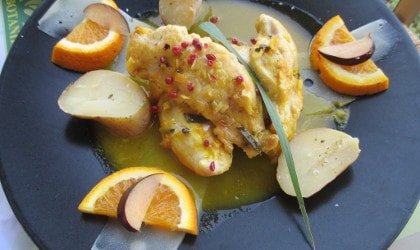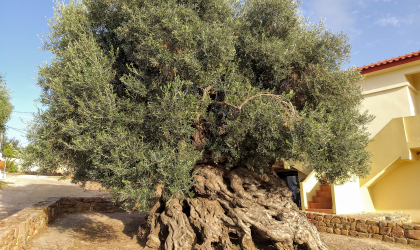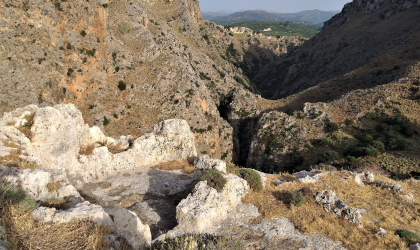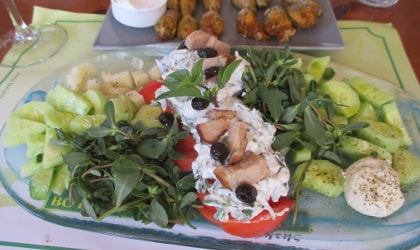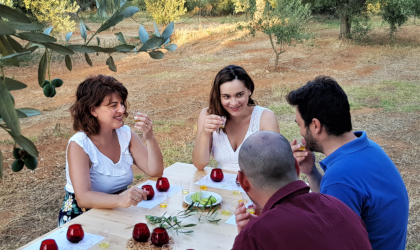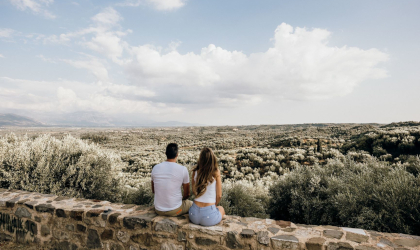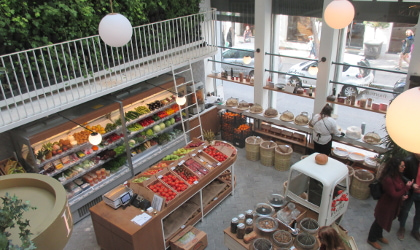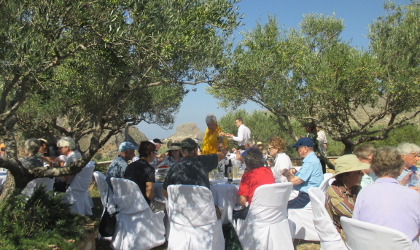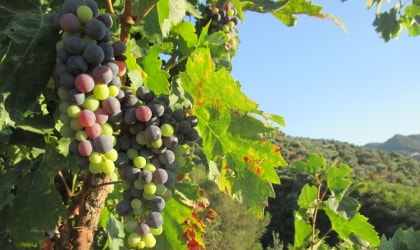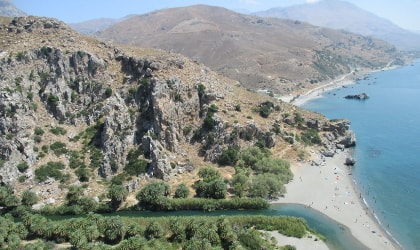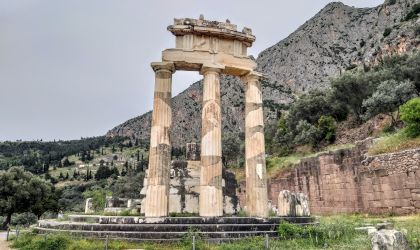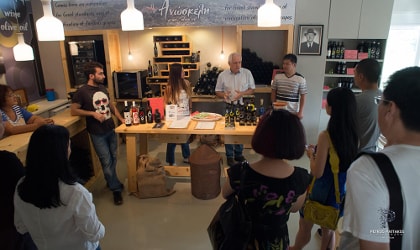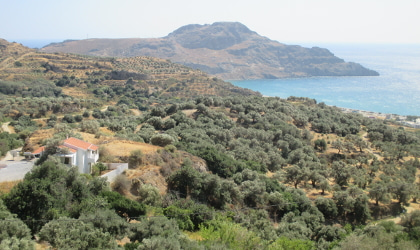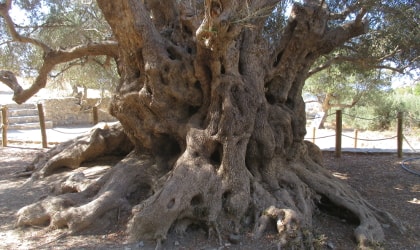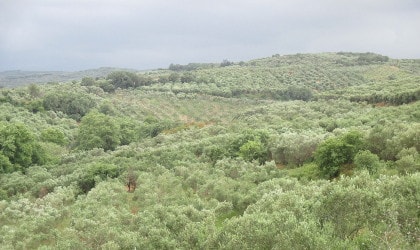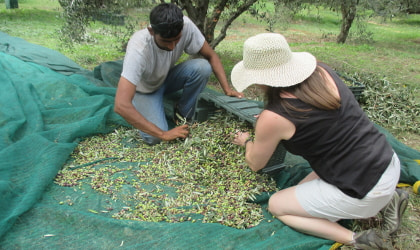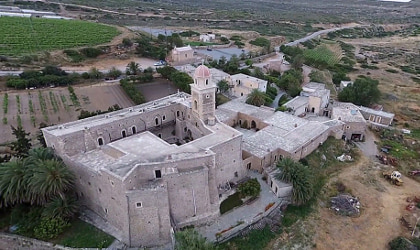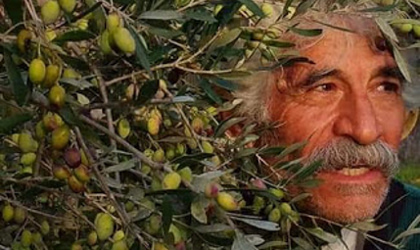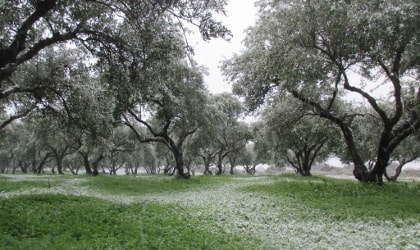- Details
- Written by Lisa Radinovsky
- Category: Agrotourism & Food Tourism
These types of tourism deserve the additional development expected in the future, but Greece already offers a rich array of choices to visitors interested in agrotourism (agritourism) and food tourism (culinary tourism). These alternative explorations allow tourists to experience the Greece that lies beyond the archaeological sites and beaches.
- Details
- Written by Lisa Radinovsky
- Category: Agrotourism & Food Tourism
Locals claim the ancient olive tree of Ano Vouves, Crete is the oldest olive tree in Greece. This may be an exaggeration, but at 3,000 to 5,000 years old, it is one of the oldest and most impressive. Although its huge trunk is now hollow, this tree still produces olives and entices tens of thousands of tourists to admire its sculptural beauty each year.
- Details
- Written by Lisa Radinovsky
- Category: Agrotourism & Food Tourism
My first encounter with the archaeological site of Ancient Rokka took place at night, accompanied by my two small children, a crowd, and an orchestra. It was the night of the August full moon, when Greece celebrates the summer with special events, including a live outdoor musical performance on a steep, rocky hillside above a village in northwestern Crete.
- Details
- Written by Lisa Radinovsky
- Category: Agrotourism & Food Tourism
What is agrotourism? How does it overlap with food tourism? What good is it? We can explore these questions with examples from Greece, one of the European countries trying to expand tourism beyond the beaches and the summer. With its wealth of olive oil, wine, and fresh produce, the Greek countryside reveals the secrets of traditional healthy Greek cuisine.
- Details
- Written by Lisa Radinovsky
- Category: Agrotourism & Food Tourism
Greece's rich culinary heritage arose from millennia of agricultural tradition. Today, visitors can explore Greek agrotourism and food tourism offerings from Corinth and Mount Pelion to the Cycladic islands. Tourists can choose from olive grove tours, olive oil tastings, farm adventures, cooking lessons, feasts with traditional local cuisine, and more.
- Details
- Written by Lisa Radinovsky
- Category: Agrotourism & Food Tourism
“Authentic and local experiences are now the major trends in the travel industry,” reports Greek tourism consultant Dimitris Palaiogiannis. In Greece, he adds, agrotourism and food tourism offerings in various parts of the country combine “the quality products of the land with a unique cultural heritage” to reward explorers with unforgettable experiences.
- Details
- Written by Lisa Radinovsky
- Category: Agrotourism & Food Tourism
Greece is an ideal culinary tourism destination. Since many visitors begin their exploration of Greece in Athens, Greek Liquid Gold checked out some popular food tourism spots in the capital where they can discover the secrets of the Greek culinary tradition: the traditional Grocery Store of the Mediterranean Diet and the new, centrally located Ergon House.
- Details
- Written by Lisa Radinovsky
- Category: Agrotourism & Food Tourism
From the southern island of Crete to northern Chalkidiki, Greek olive oil companies welcome international visitors to learn all about olive oil. In a variety of facilities and settings, tourists can explore the silvery green of olive groves, the health benefits of olives, and traditional and modern ways of getting the flavorful juice out of this fruit.
- Details
- Written by Lisa Radinovsky
- Category: Agrotourism & Food Tourism
Surrounded by olive groves in the foothills of the White Mountains, the Botanical Park and Gardens of Crete offers natural beauty, exercise, information, and healthy, tasty food. Overflowing with tropical and Mediterranean flowers, herbs, and fruits, the park surrounds an acclaimed restaurant featuring its own organically grown produce and olive oil.
- Details
- Written by Lisa Radinovsky
- Category: Agrotourism & Food Tourism
Come to south central Crete for a holiday among gorges and rivers, valleys and hillsides full of olive groves, and beaches bordered by cliffs, hills, or a palm forest, with striking views of islands and hills across bays in the Libyan Sea—plus restaurants featuring fresh, traditional Cretan food in the birthplace of the Mediterranean diet.
- Details
- Written by Lisa Radinovsky
- Category: Agrotourism & Food Tourism
By driving around the Corinthian Gulf, we can sample the various types of tourism available in Greece: beaches from Xylokastro to Nafpaktos, archaeological sites from Corinth to Delphi, endless olive groves, spring wildflowers, rivers, mountains, outdoor activities, gastronomic experiences, castles and bridges—all within a few hours’ drive of Athens.
- Details
- Written by Lisa Radinovsky
- Category: Agrotourism & Food Tourism
Too little time during your vacation in Crete? Can’t decide whether to visit an olive mill or a winery? Come to the village of Anoskeli in the foothills of the White Mountains, where you can do both at once, as well as sampling Anoskeli’s award-winning olive oil and wine in a tasting room overlooking the village’s olive groves and vineyards.
- Details
- Written by Lisa Radinovsky
- Category: Agrotourism & Food Tourism
My family and I vacation in southern Crete every year. Initially, the gorgeous beaches south of the city of Rethymno attracted us. Now, as soon as we begin to approach the dramatic gorges, the olive tree covered landscapes also capture my gaze. Olive groves nestle in valleys, climb hillsides, approach stark cliffs, and slope down toward the clear blue sea.
- Details
- Written by Lisa Radinovsky
- Category: Agrotourism & Food Tourism
3D Model created by Manolis Maravelakis, Technological Educational Institute of Crete
(And it is even more fascinating to examine such ancient trees in person, if you can get to Greece to do it!)
- Details
- Written by Lisa Radinovsky
- Category: Agrotourism & Food Tourism
If you visit northeast Crete, venture beyond the resorts of Agios Nikolaos and the unique palm forest next to Vai Beach. Discover an ancient monumental olive tree, a Greek café with a spectacular panoramic view and olive oil history lessons, a shop full of traditional local products, and a historic fortified monastery producing acclaimed wine and olive oil.
- Details
- Written by Lisa Radinovsky
- Category: Agrotourism & Food Tourism
Trivago claims Chania, Crete is Greek tourists’ favorite domestic vacation spot this summer, while Trip Advisor ranks Crete as the 2nd most popular Greek island overall, with 1215 things to do here. Remember that this includes far more than the island’s scenic beaches and fascinating archaeological sites and museums. Don’t forget the olive groves!
- Details
- Written by Lisa Radinovsky
- Category: Agrotourism & Food Tourism
How are Greek olives harvested? How is Greek olive oil made? A small international group learned the answers to these questions while enjoying a behind the scenes glimpse of a farmer’s daily life. We participated in the Cretan Gastronomy Center’s olive harvest day, following the Kalligiannis family’s olives from their trees to the village olive mill.
- Details
- Written by Lisa Radinovsky
- Category: Agrotourism & Food Tourism
If you are in northeastern Crete, deviate from the beaten track between Sitia and Vai Beach to visit the Toplou Monastery, where religion and culture intermingle with history and tradition. Toplou offers striking scenery, an impressive fortress, rare books and engravings, Byzantine icons, and the monastery’s own local wines, tsikoudia, and olive oil.
- Details
- Written by Lisa Radinovsky
- Category: Agrotourism & Food Tourism
Last November, a Spaniard who has traveled the world to photograph olive groves visited Greece. Having seen Corfu and Paxos before, Eduardo Mencos Valdes decided to explore Crete, because he believes it “is the origin, in many ways, of our culture. You can trace the cultivation and the importance of olives and olive oil back to the Minoan culture” of Crete.
- Details
- Written by Lisa Radinovsky
- Category: Agrotourism & Food Tourism
In olive oil producing countries such as Greece, tourists can wander through olive groves all year, observing the summer growth of olives, their autumn harvest, the winter landscapes, the new spring branches, leaves, and blossoms, and the cycle’s annual repetition. We can see people and nature working together to make Greek liquid gold in its homeland.
An incomplete, introductory sample of noteworthy sites to visit
Museums
- The Museum of Industrial Olive-Oil Production of Lesvos
- Cyclades Olive Museum and Chelmis Olive Mill, Andros Island
- The Museum of the Olive and Greek Olive Oil in Sparta, Peloponnese
- Lychnostatis Open Air Museum (Cretan Folk Arts, Agriculture)
- Olive & Oil Museum in Vatolakkos, Crete
- Vrana Olive Press Museum (Lesvos)
- The Chios Mastic Museum
Olive Mills
- Terra Creta Guided Olive Mill Tour and Tasting
- Biolea Stone Mill Guided Tour and Tasting
- Anoskeli Olive Mill and Winery Tour and Tasting
- Vassilakis Estate Friendly Olive Tour
- Corfu Olive Tours - The Governor's Olive Mill
- The Olive Temple Tour and Tasting, and More
- Konos Olive Oil: Makri Olives, Innovation and Agrotourism
Other Attractions
- The Routes of the Olive Tree cultural itineraries (places to visit)
- Ergon House (Foodie Hotel, Restaurant, Marketplace, Athens)
- Greek Culinary History and Cooking Adventures (Crete)
- Toplou Monastery Wine and Olive Oil Tasting (Crete)
- Yoleni's Greek Gastronomy Center (Athens)
- Irini Plomari Apartments Activities (Lesbos)
- Aristi Mountain Resort & Villas (Epirus)
- Olive Oil Bar Seminar by Gaea (Athens)
- Therianos Organic Farm (Zakynthos)
- Monumental Olive Trees of Crete
- 5 Places to Pick Your Own Olives
- Cretan Gastronomy Center
- Botanical Park of Crete
Articles
-
Dispatches From Magna Grecia, a Modern Temple of Small-Batch Olive Oil
A very good article about an agrotourism /culinary tourism venture near Ancient Olympia that features their own multi award winning extra virgin olive oil, The Olive Temple.
-
Cretans Know a Thing or Two About Good Living
Introducing the new "Center of Excellence for Health and Wellness, established in Rethymno...to raise the awareness of the international and local community regarding the significant benefits of the Cretan diet for the improvement of health," this article also includes many intriguing references to products and sites in Rethymno, Crete that will interest gastronomic tourists.
-
Oleotourism Begins to Sprout in Greece
This article about olive oil tourism in Greece provides three examples of businesses focused on this type of agrotourism and food tourism, which is becoming more popular and easier to find.
-
Chef Maria Loi's Guide To Dining In Athens
Suggestions for restaurants culinary tourists--or anyone hungry--might enjoy in Athens.
-
World Olive Day: Expanding Olive Oil Tourism in Crete
This article combines news about a World Olive Day event with information about olive oil tourism in Crete--tourism linked to archaeology, history, the diet, museums, factories, tastings, trees, and more. While the event was not designed for tourists, the report provides an overview of the wealth of olive oil tourism choices on the island.
-
Turning to Olive Oil: Two Women Head Back to Cretan Groves
Two educated Greek women turned their back on professional careers to return to family olive groves and pursue the olive oil business and agrotourism in Crete. They welcome international visitors to learn from their experience.
-
An Expert’s Greek Food Experience
"Celebrity chef and writer Diane Kochilas introduces us to a tradition that involves much more than recipes."
-
Greece Welcomes Visitors This Fall with Mild Weather and the Warm Spirit of Philotimo
"Fall is an ideal time to visit Greece to enjoy all the country has to offer," since it's less crowded, the temperature is perfect, and visitors can watch or join the olive harvest, explore olive and wine routes, taste olive oil and wine, hike, explore, and visit archaeological sites and museums.
-
GNTO submits [beautiful!] video in UN competition to promote Greece
The wonderful video linked in this article, with its poetic narration and beautifully varied cinematography, captures the elements of Greece that go beyond the incredible beaches and fascinating archaeological sites to the country's varied year-round offerings, such as the olive and grape harvests and the continuing tradition of eating and dancing together.
-
Greece Culinary Travel with Aglaia Kremezi
This starts with a nice quick overview of “the roots of Greek cuisine” in seasonal produce used in home kitchens. Next to that are links to different regions in Greece for more detail about foods and wines traditionally common in each one, the way the area’s history affected its gastronomy, and “culinary highlights” for each area: a few restaurants, shops, bakeries, delis, olive mills, or other sites culinary tourists might want to visit. Some of the links may be old, and this is by no means exhaustive, but it’s a wonderful overview. (Note: Kremezi uses “DOC” instead of PDO for Protected Designation of Origin olive oil and cheese.)
-
Alternative Tourism Greece: Gastronomy Greece
This overview from the Alternative Greece website is another good starting point for potential culinary tourists in Greece. Of course, its list of producers is too short, but it does include Anoskeli and Gaea, producers of excellent, award-winning extra virgin olive oil.
-
Local flavours of the Greek cuisine
This provides a very brief overview of many local specialties that can be found in various parts of Greece; it can be used as an introduction, to help decide what to learn more about. Hyperlinks provide more information about different locations and products.
-
Take part in a traditional [olive] harvest activity!
This is a general discussion of a popular agrotourism activity in Greece that can give you an idea of what it might involve.
-
Alternative Tourism Greece: Agrotourism - Rural tourism
This is the best very brief general overview I've seen of the benefits of agrotourism for rural economies and people, for example helping to preserve traditional customs and ways of life. It’s part of a broader alternative tourism website focused on Greece.
-
Greece agrotourism holidays
A brief overview of its title subject, with links to some agrotourism farms in various parts of Greece.
-
Nature Tourism Agritourism (Crete)
This is the online, downloadable version of the beautifully illustrated Agrotourism Guide for Crete, which discusses forests, mountains, caves, waterfalls, wetlands, flora, fauna, canyons, hikes, ecological organizations and museums, monumental trees including ancient olive trees, and opportunities to participate in traditional cooking, harvesting, and agricultural production activities.
-
Agrotourism on the Rise in Greece: Me and the Farmer
A good article about this Greek American’s personal experience as part of an agrotourism venture on a farm, with a brief overview of agrotourism in Greece and links to a few favorite agrotourism spots. (December 19, 2016)
-
Taste Escape: Where to eat and drink in Santorini, Greece
Rather than focusing on Santorini's incredible beaches and views, this article offers suggestions for those interested in the fine food and drink of the island--not only where to eat and drink, but also what to try. For many more details about all aspects of Santorini, see also Exploring Greece. (August 4, 2017)
-
Biolea: Stone Mill Destination, Organic Olive Oil Creation
Lovely scenery and an updated, hygienic version of a traditional stone mill and olive press make Biolea a popular agrotourism destination in Crete, Greece. (June 15, 2017)
-
The Ultimate Athens Foodie Guide
"A guide on how to explore some eating spots that are representative of Greek food in Athens," especially central Athens, by "a Greek-American Registered Dietitian Nutritionist and Food Writer who loves to cook, was raised on the Mediterranean Diet and lives the Med lifestyle." (May 11, 2017)
-
The Wineries of Santorini
An overview with brief descriptions and photos of 15 wineries and related museums on the island on Exploring Greece, an amazingly detailed website for tourists. (February 17, 2017)
-
Jefford on Monday: The call of Crete
"Andrew Jefford visits the high-altitude vineyards of Crete and finds an ancient wine culture in renaissance." (March 14, 2016)
-
Olive-Picking: Not All Fun and Games
A hands-on account of the most don’t-miss experience in the Greek countryside. (November 20, 2016)
-
Ancient Mill Discovered on Lesvos
"The mill, discovered during the construction of a local road, was in use from the 2nd to the 6th centuries AD." (September 12, 2016)
-
Why Culinary Tourism Matters
Culinary tourism can provide “ideas and inspiration for great taste and good health, along with a greater understanding of life in a place other than our home.” (June 21, 2016)
-
29 traditional local foods you must eat in Greece
Although the article doesn’t usually mention it, many of these are made with olive oil. (June 18, 2016)
-
The Olive Tree of Vouves
Earth Science Picture of the Day: possibly the oldest olive tree in the world, in Vouves, Crete. (July 7, 2016)
-
For Children Visiting Crete, a Free Book on Olive Oil Culture
The Association of Cretan Olive Municipalities and the International Olive Council are offering free copies of two educational books about olive oil to the children of tourists who visit Crete, Greece. (May 26, 2016)
-
Agro-Culinary Attractions in Crete Span Ages
Visitors to scenic northwestern Crete can see a traditional stone mill, one of the world’s oldest olive trees, a modern olive oil factory, and a botanical park and restaurant. (August 11, 2015)
-
Restaurants Embrace Crete’s Celebrated Diet
The personal, local, small-scale touch of hard-working Cretan families offers hope that visitors to Crete can gradually be persuaded to enjoy a traditional Cretan diet. (February 25, 2015)
-
Mediterranean Lifestyle Alive and Well on Crete
Yes, there is junk food on Crete, but this is still one of the best places in the world to immerse oneself in the Mediterranean diet and lifestyle. (March 18, 2015)
-
Immortal Island (Crete)
This article by Nancy Harmon Jenkins is the best culinary tourism article about Crete that I’ve ever read. (July 19, 2010)
-
Food History of Greece
By Susanna Hoffman, this is the most interesting food history article I’ve seen. (July 19, 2010)
-
Cretan Cuisine
This brief overview (with many hyperlinks) surveys a small fraction of the distinctive dishes of Crete and mentions the most common Cretan food products and the medical significance of the Cretan diet.
-
[Greek] Gastronomy
This short article from the Greek National Tourism Organization provides an overview of the common elements that go into Greek cuisine.
-
Ten Souvenirs to Buy in Crete
This is interesting because it begins with olive oil, half of the recommendations are for traditional Cretan foods, and it includes an explanation of each choice.
-
Manousakis Winery – Q&A with Alexandra Manousakis
The interesting story of a young Greek American who came to Crete to oversee her family's village winery, and never left. Instead, she succeeded, expanded, and welcomed visitors.


